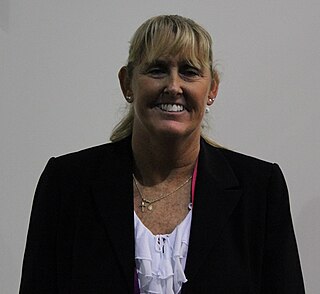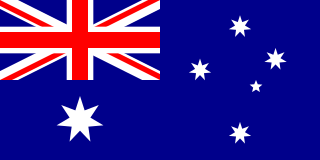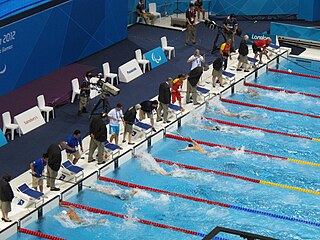
The 1992 Summer Paralympics were the ninth Paralympic Games to be held. They were held in Barcelona, Catalonia, Spain. In addition, the 1992 Paralympic Games for Persons with mental handicap were held immediately after the regular Paralympics in the Spanish capital, Madrid.
Mark Roger Tewksbury, is a Canadian former competitive swimmer. He is best known for winning the gold medal in the 100-metre backstroke at the 1992 Summer Olympics. He also hosted the first season of How It's Made, a Canadian documentary series, in 2001.
Duncan John D'Arcy Armstrong is an Australian former competitive swimmer, Olympic champion, and former world record-holder. Armstrong is best remembered for winning a gold and silver medal at the 1988 Summer Olympics.

Matthew John Cowdrey is an Australian politician and Paralympic swimmer. He presently holds numerous world records. He has a congenital amputation of his left arm; it stops just below the elbow. Cowdrey competed at the 2004 Paralympic Games, 2006 Commonwealth Games, 2008 Paralympic Games, 2010 Commonwealth Games, and the 2012 Paralympic Games. After the 2012 London Games, he is the most successful Australian Paralympian, having won thirteen Paralympic gold medals and twenty three Paralympic medals in total. On 10 February 2015, Cowdrey announced his retirement from swimming.

Priya Naree Cooper, is an Australian world champion disabled swimmer, winning nine Paralympic gold medals as well as world records and world championships. She competed in the Australian swimming team at the 1992, 1996 and 2000 Summer Paralympics with an S8 classification. She was twice the co-captain of the Australian Paralympic team, including at the 2000 Paralympic Games in Sydney, and carried the Australian flag at the closing ceremonies for the 1992 and 1996 Summer Paralympics. Cooper has cerebral palsy and spends much of her time in a wheelchair. She attended university, working on a course in health management. After she ended her competitive Paralympic career, she became a commentator, and covered the swimming events at the 2002 Commonwealth Games.

Kingsley Haldane Bugarin, OAM is an Australian Paralympic and vision impaired swimmer. He competed in five consecutive Summer Paralympics from 1984 to 2000, winning a total of five gold, eight silver, and six bronze medals. He held the Australian record for the highest Paralympic medal count until it was surpassed in 2012 by Matthew Cowdrey.

Trischa Zorn is an American Paralympic swimmer. Blind from birth, she competed in Paralympic swimming. She is the most successful athlete in the history of the Paralympic Games, having won 55 medals, and was inducted into the Paralympic Hall of Fame in 2012. She took the Paralympic Oath for athletes at the 1996 Summer Paralympics in Atlanta.
Stephanie Dixon, is a Canadian swimmer. She is a three-time Paralympian and competed at the 2000, 2004 and 2008 Paralympic Games prior to retiring from competitive swimming in 2010. During her career, Dixon won nineteen Paralympic medals and seven Parapan American Games medals, and was a 10-time world champion. She is one of Canada's most successful Paralympians.

Brazil made its Paralympic Games debut at the 1972 Summer Paralympics in Heidelberg, sending representatives to compete in track and field, archery, swimming and wheelchair basketball. The country has competed in every edition of the Summer Paralympics since.
Elizabeth Scott is a United States Paralympian. She learned how to swim at age 5, and in college was elected as captain of her college swim team, where she also set school records and won a conference title. She earned a place on the Dean’s list while studying Sport Administration and Adapted Physical Education.

Australia competed at the 1992 Paralympic Games in Barcelona for physically and vision-impaired athletes. Immediately after the Barcelona Games, the city of Madrid held events for athletes with an intellectual disability. The Madrid results are not included in International Paralympic Committee Historical Results Database. Australia finished 7th in the total medal count, winning 76 medals. Australia competed in 13 sports and won medals in 3 sports – swimming, athletics and weightlifting. Australia finished first in the medal tally at the 1992 Paralympic Games for Persons with Mental Handicap in Madrid.

Brendan John Burkett, OAM is an Australian swimmer who won five medals at four Paralympics and a silver medal at the 1994 Victoria Commonwealth Games.

S11, SB11, SM11 are para-swimming classifications for blind swimmers.
Para-swimming classification is a function-based classification system designed to allow for fair competition in disability swimming. The classes are prefixed with "S" for freestyle, butterfly and backstroke events, "SB" for breaststroke and "SM" for individual medley events. Swimmers with physical disabilities are divided into ten classes based on their degree of functional disability: S1, S2, S3, S4, S5, S6, S7, S8, S9 and S10. The lower number indicates a greater degree of impairment. Those with visual impairments are placed in classes S11, S12 and S13. Class S15 is for athletes with hearing loss. Additional classes may be reserved for swimmers with intellectual impairment: S14, S18 for swimmers with Down Syndrome or class-S14 intellectual impairment combined with a physical impairment, and S19 for swimmers with autism.
Michael Edgson is a Canadian retired Paralympic swimmer. He is amongst the most successful Paralympians of all time having won 17 gold medals. He attended three Games between 1984 and 1992, winning medals in all but one of the events in which he competed individually. As a visually-impaired athlete Edgson competes in the B3 classification.
Gregory Burns, MFA, PLY is an American athlete, painter, author, motivational speaker and member of Art of the Olympians.
Timothy Robert Reddish is an English sports administrator and former Paralympic swimmer who was the Chairman of the British Paralympic Association. Governing Board member International Paralympic Committee. He won a total of five medals at three Paralympic Games.
Robin Hugh Surgeoner is a British retired swimmer. He won nine gold medals across three Paralympic Games competing as a British Paralympian in C4 events. Surgeoner was one of the original members of the British Paralympic Association committee. He now works as a swim coach, as an inclusion empowerment consultant and musician.
Kenneth Cairns MBE is a British swimmer who won five Paralympic gold medals across five Games, along with several world titles. He broke several records in swimming events, and was appointed Member of the Order of the British Empire (MBE) in the 2001 New Year Honours for services to disabled sports.
Timothy "Tim" McIsaac is a retired Canadian Paralympic swimmer, who was born blind. He was one of the first blind swimmers to do a tumble turn in an international competition. He began swimming at the Ross MacDonald School for the Blind in Brantford, Ontario.








